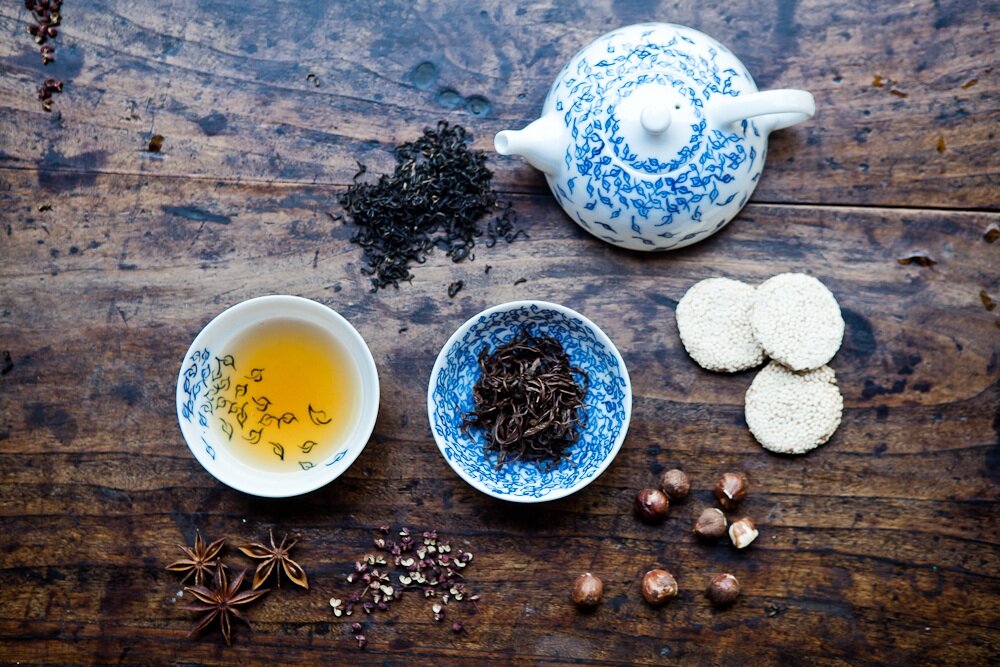The 150 year history of Qimen Keemun Tea
Qimen Keemun Black Tea © 2011 Tranquil Tuesdays
Now that the weather is getting cold, I find myself turning to one of my favorite Chinese black teas: Qimen black tea for a wonderful warming, comforting, a delicious cup of tea.
Qimen and Keemun refer to the same tea (Keemun is a 19th century spelling, Qimen uses the standardized pinyin system employed most widely today)
How Come Black Tea Gets No Love?
I think black tea tends to come across as less glamorous since it does not have all the (substantiated or not) sexy health buzz green tea and white tea does, does not have the exotic alluring name that oolong tea does, and doesn’t have the crunchy adventure back story and fanatic devotee collectors that have made millions of dollars angle pu'er tea does.
Plus, black tea is highly associated with the colonial industrial scale of tea production and trade of tea with Europe and the Americas. That brutal colonial tea industry created one of the saddest product categories of tea: tea dust languishing in tea bags most commonly used for black teas.
All this heavy tea history has somewhat maligned the category of black tea and inaccurately repped what it was capable of to the world.
(Left) Archival image of Chinese tea being prepared for export (Right) Loose-leaf Qimen black tea leaves
The first time I had a harvest fresh, single-origin Qimen black tea it was a revelation of how wonderfully complex, full-bodied, and robust really great black tea could be.
In addition to the revelatory taste experience of a great cup of Qimen black tea there is some intriuging history associated with the tea too.
Qimen Tea is named after the region Qimen in Anhui province in China where it is produced (see arrow in the map below).
In the history of Chinese tea production it has a relatively short history originating in 1875.
Anhui Province on a map of China published in 1861 by American Atlas company “Johnson & Browning” public domain
Dismissed Mandarin Creates Qimen Black Tea
This is not a photo of Yu Qianchen himself (I haven’t been able to find one. But this is a Mandarin from the same era when Yu Qianchen was himself a Mandarin).
The story goes that Yu Qianchen, a member of China’s imperial bureaucracy (elite government officials also known as Mandarins) was not cutting it at his day job, was dismissed and turned to tea.
Yu learned the process for black tea production in Fujian province and brought it back to his home region in Anhui.
Up till then Anhui was producing mostly only green tea (still the case today), but it turns out black tea was really suited for the climate and terroir of Qimen, Anhui. The result was an exquisite and memorable black tea that the world fell in love with.
Panama Pacific Exposition 1915 postcard public domain
Qimen Tea: Global Black Tea Superstar
From the beginning Qimen black tea was a global tea traded and embraced by tea drinkers outside and inside China.
European tea traders spelled Qimen “Keemun” (which considering isn’t so far off. Here are some other colonial names for globally traded Chinese tea: “congou” for gongfu, “bohea” for wuyi, or “hyson” for yuqin ) and it is often still sold today as Keemun.
China wow-ed the world at the Pan-Pacific International World Expo in 1915 where Qimen Tea was awarded the Gold Prize. More than 100 years later Qimen tea continues to be China’s most famous black tea and one of the top three major global black teas (the other two being Assam and Ceylon).
Qimen black tea is also the base for the original English Breakfast Tea blend. Though personally when I have a great Qimen I wouldn’t want to mess with it by blending it up and prefer to drink all my teas pure to really encounter and enjoy all the flavors.
In Traditional Chinese Medicine black tea is considered a warming tea and therefore a great accompaniment for colder months. If you are looking to warm up with a nice up of tea, might be time to seek out some great Qimen for yourself.






